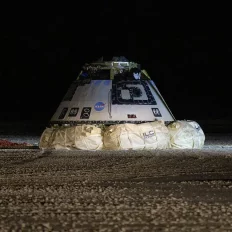This is not investment advice. The author has no position in any of the stocks mentioned. Wccftech.com has a disclosure and ethics policy.
With the weekend about to set in, NASA confirmed yet another delay to Boeing's crewed Starliner launch, making its crewed flight test (CFT) mission one of the most delayed private missions in human history. Starliner has been due to fly for years, but one issue after another has made teams replace crucial components on the ship. Ahead of the new launch date of end May, the ship last flew to the International Space Station (ISS) in May 2022 as part of its orbital flight test mission.
NASA & Boeing Aim To Fly Starliner Spacecraft Two Years After Previous Test Flight In 2022
2022's second Starliner orbital test flight came after a delay of its own when Boeing and NASA decided to stand down because of hardware problems with some of the ship's valves in August 2021. However, when the ship did fly in May 2022, it successfully docked with the ISS, allowing it to improve its performance over the previous flight in 2019. Back then, Starliner had planned to fire its thrusters to attach itself to the ISS, but it abandoned the goal and safely landed on the ground instead.
The upcoming crewed flight test will be the first time that a crew makes its way to the ISS inside a privately developed ship other than SpaceX's Crew Dragon. Like Dragon, Starliner is part of NASA's Commercial Crew Program (CCP) - an initiative that spurred private spaceflight vehicle development.
Apart from being Boeing's first crewed flight attempt, CFT will also be the first time that the Boeing and Lockheed joint venture ULA launches humans into space. ULA's Atlas V rocket is one of the longest running launch vehicles in the world, and Starliner's first launch attempt this month was scrubbed because of a pressure regulation valve problem on the Atlas V's second stage.

NASA's release confirming the delay shared that the leak would not be dangerous during flight—a conclusion NASA and Boeing reached after a systems test on May 15th. According to NASA, Boeing teams are currently "working to develop operational procedures to ensure the system retains sufficient performance capability and appropriate redundancy during the flight."
Starliner's thrusters are a key part of the ship since they are responsible for its docking and un-docking maneuvers. Without them, the ship cannot approach the ISS, with strict NASA guidelines for any spacecraft movement in the station's vicinity raising the stakes for reliable thruster performance.
The new launch date is now May 25th, with the Atlas V, or 'mighty Atlas' as ULA chief Tory Bruno likes to call his rocket, slated to lift off in the afternoon. NASA added in its release that while Boeing is working on testing the Starliner's thruster systems for flight, the final decision to head into the launch countdown on the 25th will also see input from the ISS Program Office.
After its scrub earlier this month, the Atlas V was cleared for another launch attempt on the 21st, which was Starliner's launch date before the latest delay.





